Riverine Warfare
In the mid-1960’s, U.S. strategists devised a plan to patrol rivers, canals and streams of the Mekong Delta by use of U.S. Navy boat crews with U.S. Army troops. These forces sought to destroy men, materials and areas loyal to the Communists.
A brigade of the US Army’s 9th Division infantry were the troops. Four River Assault Squadrons of mini-warships and transports manned by US Navy crews provided transport and gunfire support. The ships moved up, down, and across the Mekong waterways whenever there were reports of Viet Cong and where water depth would permit. The LSTs, though over three hundred feet in length, were of shallow draft when compared to other ocean-going ships, and were well suited to the shallow waters of the Mekong’s main rivers. The smaller converted landing craft could enter the very shallow streams and canals to attack Viet Cong bases and villages. Sometimes, they carried the war into waterways of only a few feet of water depth. They were totally dependent on the larger ships for food, fuel, ammunition, and crew sleeping quarters.
When not on patrol or conducting assaults, the boats nested to large pontoons or floating platforms tied to the side of “motherships”. As the ships traversed the rivers, they towed the pontoons alongside. These forty-by-one hundred foot floating piers served as staging areas for the loading and unloading of troops and equipment. Sailors of the ship’s crew assisted soldiers in the preparation for each assault by manning cargo-handling equipment, and ship board guns in support of the attack.
Army troops lived aboard the ships and aboard large barracks barges which, having no propulsion of their own, were towed about by tug boats. Home for all was the ships on the river, the Mobile Riverine Base. The land was unfamiliar and foreign. Muddy banks along the river, rice paddies and the tropical jungle and forests were the intended battle grounds, though frequently the bloodshed spilled to the villages and towns.
On orders, in support of operational plans, troops donned their battle togs, strapped equipment, C-rations and ammunition to their bodies and rushed to board waiting landing craft. Navy boat crews gunned diesel engines as they waited alongside the pontoon piers. Other craft circled in the water nearby awaiting their turn at the pontoons. Though personal items were not permitted to be carried into combat by the troops, many carried small radios or cassette tape recorders, their last links to their own culture. Sergeants checked each man for readiness, sometimes removing some of the larger prohibited items. The troops ran down gangways and accommodation ladders onto their craft, and away they went for one more battle in an unknown spot in a foreign, hostile land. The ships could never really be home, but at these times they were the only American territory and preferable to what lay ashore.
Operations varied in length from several hours to several days. Unscheduled or unplanned events sometimes stretched the time to a week or, infrequently, to as much as ten days. But generally, they were back aboard in a day or two for hot food and clean bunks. Though no beer or other alcoholic drinks could be consumed on U.S. Navy ships, the pontoons alongside were not commissioned vessels, and returning troops received two iced cans of beer to be consumed on the pontoons, prior to returning aboard ships. Many disdained the beer, being too weary and emotionally drained to care about anything but sleep. Others gladly accepted their buddies’ beer ration in order to get a fair glow on before crashing into their bunks. Still others sought secret spots about the ship to share a joint.
In addition to the ships permanently assigned to the Mobile Riverine Force, an LST of Korean War-Vintage was assigned to the river force from the ocean-going fleet. The larger, faster “fleet” LSTs, which carried a greater amount of troops and cargo than the others, were assigned for three or four months at a time. They were then relieved by sisterships. A turn over of assigned troops, equipment, and cargo was conducted between the ships. The “fleet” ships were not treated as “family” by the ships permanently assigned to the Mobile Riverine Force (MRF). They were rather a larger but distant relative allowed into this special “family” occasion. But all ships had in common the hull design of the LST, a unique and versatile ship.
Troops, tanks, trucks, ammunition, and food were common cargo for LSTs . Ill-designed for the open sea, they rolled and pounded, straining every weld and will. While the destroyers, cruisers, battleships, and carriers steamed in relative comfort, LSTs responded to even moderate seas by dancing in a violent manner while seeming to come apart.
In Viet Nam, their versatility again came to the aid of U.S. strategy as they took on the normal duties of ocean-going lift, assignment to Amphibious Ready Groups which were the amphibious assault unit of the U.S. Seventh Fleet. Eight faster 1156 Class LSTs, homeported in Yokosuka, Japan were assigned added tasks of special operations in the rivers of the Mekong Delta assigned to The Mobile Riverine Force(MRF) a joint Navy and Army command.
I assumed command of Washtenaw County in April 1966 and immediately went into training to learn amphibious skills. My only experience aboard an LST was having had lunch on one. My background was in aviation, cruisers and destroyers.
When ordered from the Pentagon to LST duty I was disappointed for I had hoped for command of a Dealey Class destroyer escort or other destroyer type ship. But I was still thrilled at the prospect of command at sea. The ship, crew and I went through a period of training in amphibious operations. Then we had numerous deployments from Yokosuka hauling materials from port to port in support of the Viet Nam War as it heated up. There were combat operations in 1966 and 1967 with the Amphibious Ready Groups. The greatest challenge was yet to come. In December 1967 we received word that Washtenaw was scheduled to join the Mobile Riverine Force for combat operations in the Mekong Delta of Viet Nam. We had Christmas 1967 in Yoko and prepared for our next and most challenging assignment.
The Washtenaw County was assigned to the Mobile Riverine Force in early January of 1968. a Korean War class LST, the ship assumed the task of transporting and supporting troops and craft. Her tank deck was crammed with ammunition, and she set forth for “Injun’ country”, i.e., Viet Cong territory.
The year 1968 was ushered in by this traditional poetic entry in the ship’s deck log on New Year’s night.
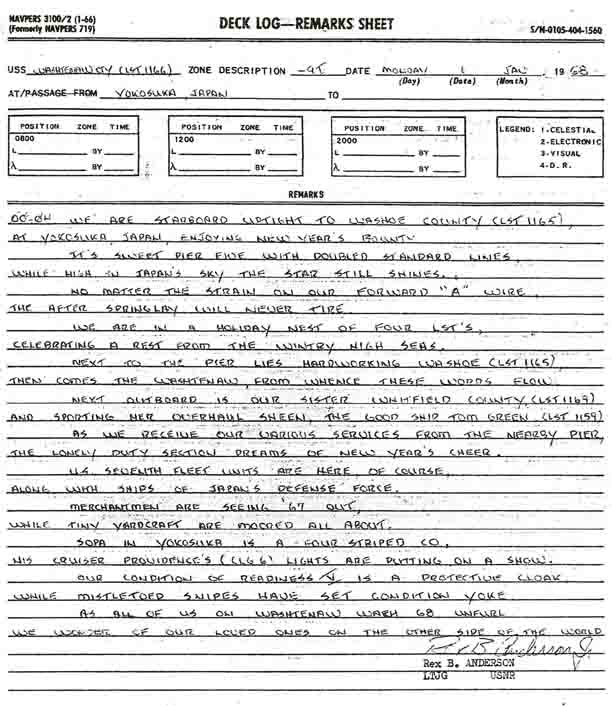
We had spent most of the month of December 1967 in our home port of Yokosuka and many of the crew had the joy of spending Christmas with their wives and children. The ship had a period of material upkeep and was in splendid condition as we prepared to resume our operational schedule. The uncommon lengthy period was a relief from a schedule which had us out of home port for about eighty per cent of the time.
As Rex Anderson composed the New Year’s log entry, the USS Pueblo was moored nearby preparing for the voyage which was resulted in her capture by the North Koreans and the crew’s imprisonment for all of the unhappy year 1968. Pueblo got under way for an intelligence January 5, 1968, and was intercepted by the North Koreans three weeks later. Washtenaw departed January 8 for the Mekong Delta and combat operations with the joint Army/Navy Mobile Riverine Force, CTF 117.
The Mekong Delta was familiar to us. In September 1966 the Washtenaw had transited from Vung Tau up the Song Tian Giang River to a crossover river and steamed down the Bassac River past Long Xuyen to Can Tho/Binh Thuy where we moored to a small pier at ninety degrees to a river current that sometimes reached six knots. It was a precarious spot and at one point, despite steaming to the beach, and with all available mooring lines the ship was swept from the pier as all lines parted with the exception of a seven inch spring-lay line which had been “cumshawed” by our resourceful Supply Officer Gary Palmer. The spring lay, a combination of manila rope and wire, stretched but held us at an angle with the stern way out from the pier. Mike Gregovich was on the bridge. We sounded the danger signal and the Bechtel company civilian tug, Makah, anchored a mile away, came to our rescue and pushed us back snug to the pier. We tied up using everything we had but our shoe laces. Extraction from that pier after loading was an experience I never want to have again. Despite the current we managed to avoid demolishing the PBR base on our port side.
Up to that time Washtenaw was the largest ship ever to make that trip and established a speed record when retracing her entry by steaming back up the Bassac to the crossover and down the Song Tian Giang. The speedy transit was accomplished by catching the flood tide when going up the Bassac and the ebb while going down the Song Tian Giang. There were times during the transit from Can Tho to Vung Tau when the ship, making turns for flank speed and boosted by a six knot current, made a speed over the ground of 20-21 knots. We were under the operational command of Commander Naval Forces Viet Nam in Saigon where some bright staff planner, seeing our speedy trip downriver, ordered us to proceed from Vung Tau to Danang at a speed of 18 knots. Not possible, for steaming north along the coast into the southerly current we could only make 11-12 knots.
In January 1967 we were back in the Mekong Delta as we participated in Operation “Deck House V” and pioneered the use of the 1156 class LST in assault operations in the treacherous and shallow waters of the Mekong. It was the first assault by US Marine Corps units in the Mekong. For several nights the ships in the assault element transited shallow water areas to the assault beach. Twice the ships were recalled and rescheduled for the next night The traditional assault day breakfast of steak and eggs for troops and crew nearly exhausted our supply of beef steak. In the final run into the beach the little convoy led by the St Francis River an LSMR 525 (Landing Ship Medium, Rocket),. followed by the Coconino County LST 603 and the Washtenaw reached the landing area, launched Marine LVT’s and provided gunfire and logistic support. Washtenaw then beached at the mouth of the Co Chien River to complete offloading Marine equipment. In a 9 January 1967 letter to Commander Landing Ship Squadron Nine I wrote:
“This has been the highlight of my tour so far, until now I had not really appreciated the Amphibs, now I love it. This ship is a great machine and a good friend. It will be a damn shame to take her back to logistical and administrative lifts. I wish we could stay with ARG (Amphibious Ready Group) indefinitely.
Based on observations of this operation, I believe LST's coupled with LSMR’s (IFS) could carry and support the necessary troops to clear the whole damn Mekong. If that sounds like a job for LANSHIPRON Nine, That’s exactly what I mean. The LST’s carried the first troops and the only artillery which landed on D-Day. The LSMR provided the most effective supporting arms.
Navigation in was hairy but mainly because of the uncertainty, the sea state and wind conditions. A Coast Guard WPB guided the way and Fred Mangol (CO of St Francis River) was something to behold. From his position ahead he was able to keep other units informed of fish traps and other hazards.
On D-Day we had a ringside seat and had no difficulties in anchoring by the stern, launching LVT’s and then beaching. Our only disappointment was that we did not control the boat waves. Control was kept with CLSTDIV 92 in Coconino County.
The waves were late, but fortunately so, as the Air Force was quite late with there ordinance; and somewhat inaccurate, I might add. Two 500 pounders were dropped perpendicular to the beach, ricocheted and landed 500-700 yds from the ship. Duds, thank God as they were quite close to the second wave of LVT’s.
Our beaching site was 700-1000 yds from the Maine CP and the mangrove in front was not secure.”
Washtenaw remained on the beach to backload and support the Marines for several days. Included with normal support we also provided hot meals and cold beer as a present for the guys ashore. The Marines had a great appreciation for our ship. Several weeks later at the Subic Bay officer’s club, Lt Col Bob Christian introduced me to a Marine general as the CO of the ship that treated embarked Marines the best of any Navy ship he had ever seen.
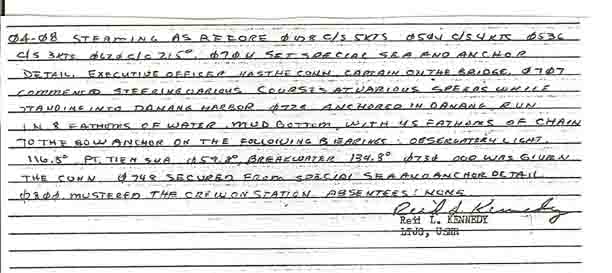
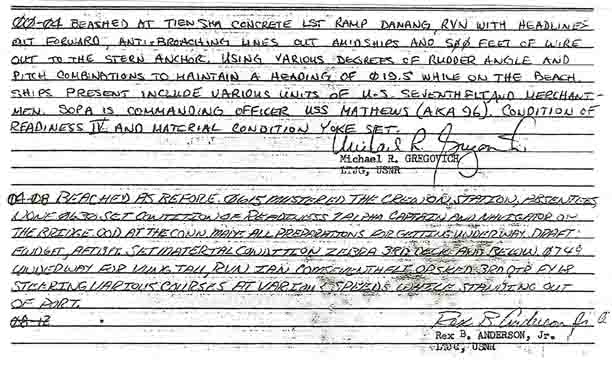
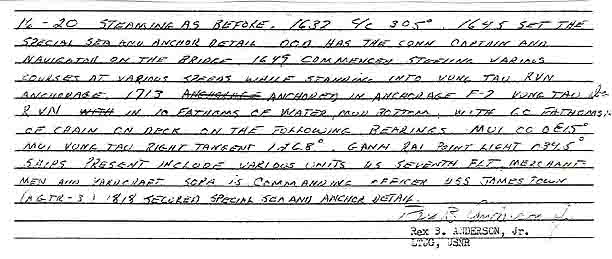
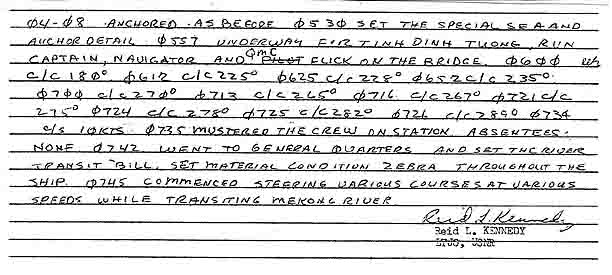
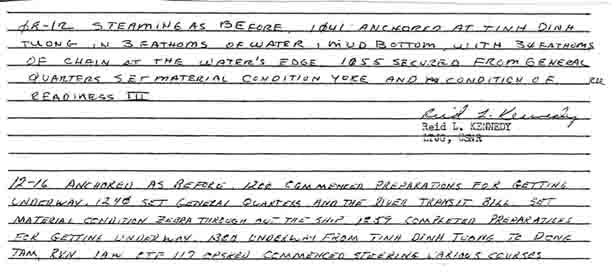

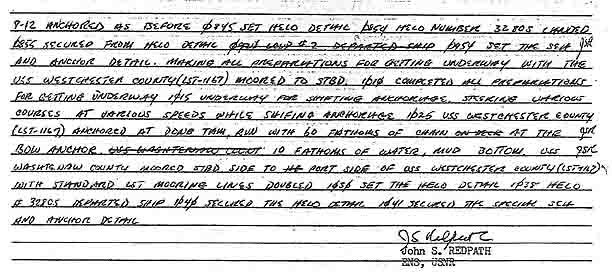
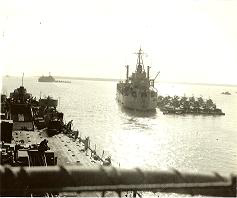
Our first ten days with the Mobile Riverine Force was relatively uneventful as we got accustomed to the routine of troop debark and embark, relocation of the ships of the Mobile Riverine Base, shifting anchorage and almost continuous helo ops.
Everything changed on January 31, 1968 and the TET offensive began. Washtenaw was anchored close to shore at Vinh Long in a lake at the confluence of two rivers. We were anchored apart from the other ships for their safety as we were fully loaded with thousands of tons of munitions.
A cease fire had been agreed to, we were told. The next day we received small arms fire from the south shore. On reporting it, I was told, that was friendly territory and the firing was probably the South Viet Namese celebrating Tet by firing into the air. I replied “I don’t know about friendly, but somebody over there doesn’t like us.” We then shifted to a safer anchorage. Later we receive word of heavy fighting up north and the cease fire was called off. For the next month all hell broke loose.
The continuous operations are described in the Presidential Unit Citation we received as part of the Navy of the Mobile Riverine Force:
“CITATION:
For exceptionally meritorious and heroic service from 29 January to 4 March 1968 while engaged in armed conflict against communist insurgent(Viet Cong) forces in the Republic of Viet Nam. Throughout the Tet(Lunar New Year) Offensive, the Mobile Riverine Force(MRF) was locked in nearly continuous combat as the enemy lay siege to or threatened to attack every large population center and military installation in the Delta. During their hectic, 35-day campaign, the MRF played a vital role in driving the enemy out of My Tho and Vinh Long, the most severely ravaged of all the Delta cities, and in preventing enemy from launching sustained attacks on Can Tho, Binh Thuy, Sa Dec, Cai Be, Cay Lay, the Army Base at Dong Tam and many other less populated areas.” The rest of the citation may be found on the web-site “Brown Water LST”
There are so many wonderful things I could write about the Navy and Army men of that riverine war. Of the sacrifices, the comraderie, the bravery and dedication I remember so well. The times we ran our variable pitch propellers and dropped concussion grenades over the side to prevent underwater attack, at the cost of our own sleep. The night we received a rocket hit on the port side and Al Hamilton got guns firing in reply and the time he rescued a man overboard. The night we were bracketed by five mortar rounds any one of which had it landed on deck would have blown us up. Of the somber, gentle way our sailors received on board the body bags containing the fallen. I have a number of stories which will be addendum to this memoir.
On March 25 we were relieved by the Tom Green County LST 1159. Commodore Robert S. Salzer, CTF 117, came aboard to say goodby and said “Al, I never thought you would make it.” He had expected us to get blown up.
As we headed down river to Vung Tau a long line of the MRF assault boats passed us on their way back from a mission. Each boat in its turn sounded its horn in salute to our ship. It brought tears to my eyes. I was sad to leave them, but glad to be leaving the river. Washtenaw went to Bangkok,Thailand for a visit where LCDR Jim Burpo reported aboard as my relief. We went to Sattahip, Thailand for a load of steel. After waiting a week for the load we decided to pull the plug and Jim relieved me of command, and blessed with a great crew he carried on the traditions of the Washtenaw County.
I went the Chao Phaya Hotel in Bangkok, and soaked in a bath tub for three hours, feeling the weight of command drift up in steam from my body. Refreshed I flew to Yokosuka for debriefing and then back home.
© 2005, Alfred Dillon